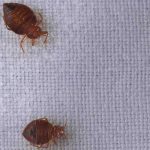
We’ve previously written about the movement to save important pollinators like bees, and maybe that article caused you to think twice about breaking out the insecticide in your Illinois garden. But it’s difficult to muster that same sympathy for their winged brethren – wasps. Not only are they sting-happy and easily agitated, they just look mean. And when they swarm to attack, their stings can cause allergic reactions that could prove fatal.
You may be surprised to learn, however, that wasps do provide some necessary functions within an ecosystem. At Terminix Anderson, we specialize in environmentally friendly wasp control in Illinois and across the Midwest. We believe it’s our duty to educate as well as protect our customers from the many pests they live with every day. So, you might be wondering: Just what are wasps good for?
What’s Up with Wasps?
Wasps belong to the order Hymenoptera, which is actually quite large and encompasses other insects like sawflies, bees, and ants. From there, they split off into the family Vespidae – you might recognize the root word, “vespa,” which is Italian for “wasp” and also a popular brand of motorized scooter. Wasps first appeared in the fossil record during the Jurassic period, and have since become one of the more successful insect groups on the planet. Tens of thousands of wasp species exist all over the globe, minus the polar regions.
Most of these species can be grouped into two categories: solitary wasps and social wasps. When you think of wasps in Illinois, you typically think of winged insects buzzing around visible nests that cling to the eaves of your house or hang from a nearby tree. These are social wasps, and contrary to what you might think, they only account for about a thousand species, while solitary wasps are by far the largest subgroup.
Solitary Wasps vs. Social Wasps
Solitary wasps do not form colonies, hence their name. Once the female has mated, she goes off alone to lay her eggs in small burrows or nests and hunt food for her offspring. Many of these wasps are predatory, using their stinger’s venom to paralyze prey. Next, they either lay eggs on (or sometimes within) the paralyzed creature, leaving the larvae to hatch and devour the carcass, or the adult wasp brings the captured prey back to her lair – where her very hungry children are waiting.
Some of the largest-known wasp species are classified as solitary:
- Cicada killers
- Tarantula hawks
- Mud daubers
- Potter wasps
Social wasps, on the other hand, behave much like their bee cousins. They construct elaborate nests made from chewed wood fibers or mud to house and protect their colony, including the queen and her eggs. These nests contain a similar “honeycomb” pattern as bees, but unfortunately wasps don’t produce honey themselves – at least, not in any form that you’d want to eat.
Depending on the species of social wasp, they build their nests anywhere from trees and shrubs to crawlspaces and underneath eaves. When winter approaches, a new fertilized queen literally makes a beeline for a warm spot in which to hibernate, leaving the old queen and remaining colony to collapse and die off. Once spring arrives, she emerges and rears a small brood of workers to help her construct a new nest, and the circle of life continues.
A few examples of social wasps in Illinois you may recognize:
- Yellowjackets
- Hornets
- Paper wasps
Why Are We Afraid of Wasps?
When you consider how long wasps have been around, it makes a bit more sense why they’re as aggressive and territorial as they are. Like any other creature, they’re simply trying to survive. But even the most forgiving, nature-loving person can have a tough time putting up with wasps near their home, especially if they have small children. Why is it that humans and wasps have such a tough time coexisting peacefully?
Feeding Habits
The first reason is they like to eat the same things we do, and neither party takes kindly to sharing their food. In addition to other insects, wasps enjoy eating a variety of things:
- Fruit like apples, pears, and grapes (especially rotting and fermented fruit)
- Nectar (mostly eaten by male wasps)
- Sugary substances (if you’ve ever found a wasp floating in the Kool-Aid at a picnic or barbeque, you know this already)
- High-protein foods like tuna or salmon
In late summer, social wasp nests stop producing new workers and begin the long wind-down until winter. During this time, the larvae in the nest stop producing a sticky sweet substance the adult wasps feed on. As a result, the wasps become much more aggressive in searching for sweets this time of year. And what else happens during late summer in Illinois? People have picnics with lots of sugary and protein-packed foods.
Proximity
Not only do wasps enjoy raiding our late summer cookouts, they also enjoy building nests on, around, and sometimes inside our homes. Yellowjackets have no qualms about making your crawlspaces their new home, and paper wasps are content to hang out under your eaves or just inside your covered decks. It’s difficult to “live and let live” when these unwanted houseguests simply invite themselves in.
Sting
If you’ve ever been stung, this is a no-brainer. Wasp stings hurt, and in certain cases they can be deadly. Normally, a sting results in pain, redness, and swelling, all of which subside over time. However, those who are allergic to wasp stings are in danger of going into anaphylactic shock, which is a severe allergic reaction that can be life-threatening unless treated immediately at a hospital.
Unlike bees, wasps can sting more than once, which makes them especially dangerous to those they perceive as threats. However, it’s important to keep in mind that only female wasps can sting, and will only do so if repeatedly provoked.
You can try to avoid wasps if you want, but just like us, they’re most active during the early morning and late evening hours when the summer sun isn’t so hot. Recent studies have shown that certain social wasps can give off a pheromone when threatened that alerts other wasps to the danger. Unless you’re prepared to deal with reinforcements, you’re better off leaving the wasp control to the professionals at Terminix Anderson.
Remind Me Again Why Wasps Are Actually Good?
Keep in mind that while wasps do have some likable properties, they’re still dangerous. Bears provide lots of value to an ecosystem, too, but you don’t want to go cuddle with a wild one anytime soon. That being said, there are a couple of reasons why we should be thankful for wasps.
- For starters, they’re an incredibly effective form of natural pest control in Illinois. Because wasps are omnivorous, they will seek out fruit and nectar just as often as they prey on other insects we might consider pests. In addition to spiders, they’re also fond of hunting grubs, caterpillars, aphids, and weevils. Some farmers have introduced specific species of wasps into their fields to help control crop-destroying pests – in Brazil, farmers control sugarcane borers using several species of parasitic wasps. This doesn’t mean the wasps you see in your garden are as effective as pesticide, but they’re certainly less harmful to the environment.
- Another benefit wasps don’t get credit for is their proclivity for scavenging. Yellowjackets in particular are known for snatching up dead insects to feed their young. And remember how much wasps love rotting fruit? Without them around to clean up that garbage, you might be reading this while half-buried in dead caterpillars and decaying apples.
- Some wasps also play important roles as pollinators, too. They’re not as prolific as their cousins, the bees, but think of how empty the world (and your stomach) would be without the fig wasp, sole pollinator of the fig plant. And recently, researchers in Italy discovered that certain hornets and paper wasps are responsible for the wine, beer, and bread we consume. By feeding on late-season grapes, these wasps carry wild yeast cells inside of them. The yeast survives the harsh winters in the stomach of hibernating queens, and is then transferred back to the next season’s grapevines in the spring. You could say they deserve a toast (and some actual toast) for that!
Call Terminix Anderson Pest if Your Wasp Control Gets Out of Control
It’s good to know that wasps can help as much as hurt, but that doesn’t mean you should put up with them just because. If you feel like wasps are a threat to the health and safety of your family, don’t wait to act. While some people have had success with DIY wasp control, you should know the risks going in.
Using pesticides or other poison to kill wasps can be hazardous for humans, in addition to animals that may feed on their carcasses. If you’re going to spray, do so at night or very early in the morning when wasps are least active, and make sure to properly dispose of the nest as well as any dead wasps you see. Remember, wasps will attempt to defend themselves, so be sure you’re wearing protective gear. And never, ever spray chemicals inside your home.
Environmentally friendly wasp control can be a daunting challenge, and in most cases, you’re better off leaving the dirty work to a professional. At Terminix Anderson, our trained professionals have the experience necessary to rid you of your wasp problems quickly, safely, and without harming the environment. Contact us today to schedule a consultation and service.





